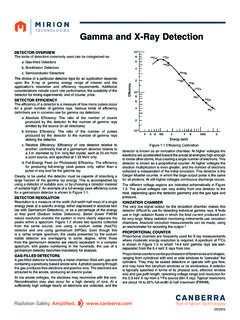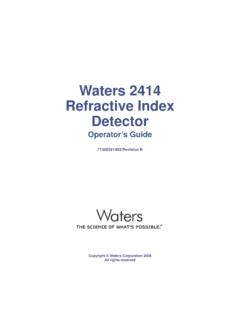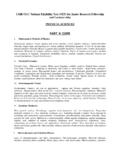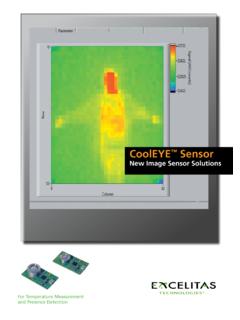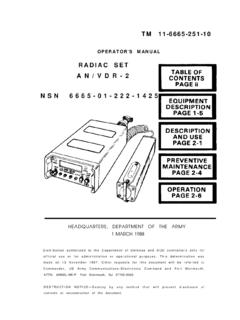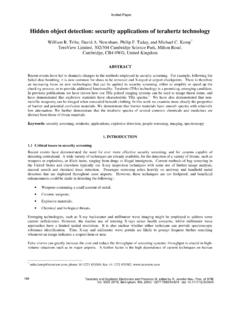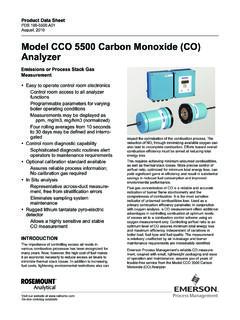Transcription of Areviewofdesignconsiderationsforthesensormatrixin ...
1 UNCORRECTED PROOFN uclear Instruments and Methods in Physics Research A 0 (2001) 1 30A review of design considerations for the sensor matrix insemiconductor pixel detectors for trackin gin particle physicsexperimentsSally Seidel*New Mexico Center for Particle Physics, Department of Physics and Astronomy, University of New Mexico,800 Yale Blvd NE, Albuquerque, NM 87131 USAR eceived 9 December 2000; accepted 26 January 2001 AbstractMethods have been developed to improve the reliability of silicon sensors, in particular for pixel detectors, and theirresistance to radiation damage, as it is encountered in tracking detectors in particle physics experiments. The choice ofwafer material, the processin gtechniques, and the sensor layout are discussed. Alternative semiconductor substratesand variations on the planar hybrid design are mentioned.
2 #2001 Published by Elsevier Science :&;&;&Keywords:&;&;&1. IntroductionThe principal focus of this paper is the design ofthe silicon sensor part of a pixel , the included material was part of afull-day course on active pixel detectors. The otherlectures treated the electronic readout chips, thehybrid interconnection technologies, and development of pixel sensors is an extensionto two dimensions of the silicon microstrip sensortechnology, many of the features of which aredescribed in Refs. [1,2]. This two-dimensionalapproach requires innovation in interconnectionsand electronics signal processing not describedhere. A silicon pixel sensor is defined here to be thesensin gelement of a hybridized detector, includin ga lightly doped substrate (usually n-type), one ofwhose surfaces is in contact with highly dopedsilicon of the opposite type (correspondingly, p-type), thereby formin ga junction.
3 The oppositeside of the silicon wafer is in direct contact withhighly doped silicon of the same type as the highly doped silicon will be referred to here as the implants , although in fact it can beintroduced through implantation or implants on both sides of the device can beelectrically contacted. When a reverse bias voltageVBis placed across them, a region in the bulksilicon is depleted of free charge carriers. ThewidthWof the depletion region in the n-type bulk135791113151719212325272931333537394 1434547495153555759616365 NIMA:40923 : COMED:MALLIKARJUNAPAGN: BALA // BVR SCAN: ^30 (col. g.: NIL)*Tel.: 505-277-2616; fax: (S. Seidel).0168-9002/01/$ - see front matter#2001 Published by Elsevier Science : S0168-9002(01)00695-7 UNCORRECTED PROOFis given byW ffiffiffiffiffiffiffiffiffiffiffiffiffif fiffiffiffiffiffiffiffiffiffiffiffiffiff iffiffiffiffiffiffiffi2eVBqNd 1 Nd=Na swhereeis the silicon dielectric constant,qis thecharge, andNdandNaare the donor and acceptorconcentrations, respectively.
4 Typical sensors usedfor particle physics applications utilize bulk siliconofNd 1012atoms=cm3and implanted silicon ofdopant density greater than 1014atoms= form a pixel sensor, the implant on one ofthe sides of the wafer must be segmented intoregions, called pixels, each of which is ultimatelyattached to its own preamplifier circuit to form anindividual channel of the detector. Typical dimen-sions of an individual pixel are such that its area isa number on the order of 2 104mm2. When sucha pixel sensor is placed in the path of a chargedparticle, the traversin gparticle produces electron hole pairs through ionization along the length ofits track in the silicon. If the sensor is adequatelydepleted, the electrons will drift to the n-typeimplants, and the holes to the p, from either ofwhich appropriate electronics can read the signalsout.
5 Interpolation between signals from differentchannels, either on the basis of their time or theirpulseheight, provides information about the pathof the traversin gparticle. Depletion of intrinsicsilicon bulk essentially eliminates the free carriers(which, with a density of about 1:45 1010cm 3,outnumber the signal carriers by four orders ofmagnitude).The usual environment in which pixel detectorsare operated for particle physics applications isone of high luminosity and close proximity to theinteraction point or particle source. The highluminosity is required for sensitivity to rare events;it often, however, implies high radiation proximity permits precision trackin gandallows on-line triggers to examine tracks whiletheir curvature is small, often simplifyin grecon-struction algorithms and speeding trigger deci-sions.
6 Increased proximity exacerbates radiationdamage, however. Furthermore, as particle trackdensity is highest near the production point, atracker s granularity must be increased as itsdistance from the interaction point is desire for fine granularity makes silicondetectors a natural choice for tracking; however,while the very small feature size available in silicondevices provides low capacitance, low noise,consequently good signal-to-noise ratio, and lowoccupancy per channel (which reduces eventbufferin grequirements), the radiation dama ge,which increases capacitance and creates chargetraps, must be addressed in the design. Pixels small feature size and typically harsher radiationenvironment have placed constraints upon pixeldesign beyond those required for strip sensors;these are a subject central to this paper.
7 Specifi-cally, pixel sensor design and development haveborrowed what was useful from silicon strip sensordesign while focusing on the following issues: (1)engineering for robustness of radiation-damagedsensors designed with proven technologies; (2)maximizin gthe radiation hardness availablethrough new technologies; (3) minimizing thesensors capacitance and maximizin gtheir si gnalcollection; and (4) explorin gnew desi gn so many aspects of silicon pixel sensordesign are influenced by radiation hardnessrequirements, the first section of the paper brieflyreviews the response of silicon to radiation. Thefirst section is not intended to be a complete reviewof radiation damage effects, but is merely intendedto provide foundational information upon whichspecific design choices described in subsequentsections are Radiation damage in IntroductionRadiation damage is caused by the passage ofparticles through the sensor.
8 The main source ofcharged particles is collisions at the interactionpoint, so their fluence is proportional tor 2. Themain source of neutrons is backsplash from thecalorimeter, so their fluence depends on theapparatus shieldin gand desi gn. Bulk and surfacedamage are induced by different mechanisms, sothese are considered separately below. The symbolFis used here to represent fluence. An excellent1357911131517192123252729313335 3739414345474951535557596163656769717375 77798183858789919395S. Seidel / Nuclear Instruments and Methods in Physics Research A 0 (2001) 1 302 NIMA:40923 -UNCORRECTED PROOF recent review of radiation damage effects in siliconmay be found in Ref. [3]. Bulk damageParticles passin gthrou gh a silicon substrate cancause dislocations in the lattice that alter the bandstructure.
9 Followin gthe collision, the displacedatom (or Primary Knock-on Atom, PKA) be-comes a silicon interstitial and leaves a combination of vacancy and interstitial atomis known as a Frenkel Pair. In silicon, approxi-mately 25 eV are required to displace the PKA [4].The semiconductor bulk damage model postulatesthat the recoilin gPKA strikes nei ghborin glatticeatoms, and if its energy is greater than about2 keV;its action will lead to the formation ofclustered damage sites of typical volume 10 19cm3[5]. Interstitial atoms and vacancies that escape acluster and migrate through the lattice aregenerally trapped at the impurity atoms and formpoint defects. The subsequent evolution of theclusters and=or point defects is thought to producecertain macroscopic effects that are damage done by radiation to silicondepends upon the type and energy of the bulk damage is generally thought to dependexclusively on the non-ionizin gener gy loss( NIEL ) of the particle.
10 This fact, which hasbeen demonstrated to be the case over 14 orders ofmagnitude in particle energy, is called the NIEL hypothesis. (Some deviation may be apparent inthe case of oxygenated silicon substrates; seeSection below.) It is consequently possibleto scale the damage caused by different particlespecies at various energies by the NIEL, or by anequivalent scale factor known as the displacementdamage function. The displacement damage func-tion, which may be calculated by combinin gtheindividual reaction cross-section, the energy dis-tribution of recoils produced by that reaction, andinformation about the partition between ionizingand non-ionizin gener gy loss of the recoils, andthen summin gover all reaction channels availableto the initial particle at its energy, is shown inFig.
